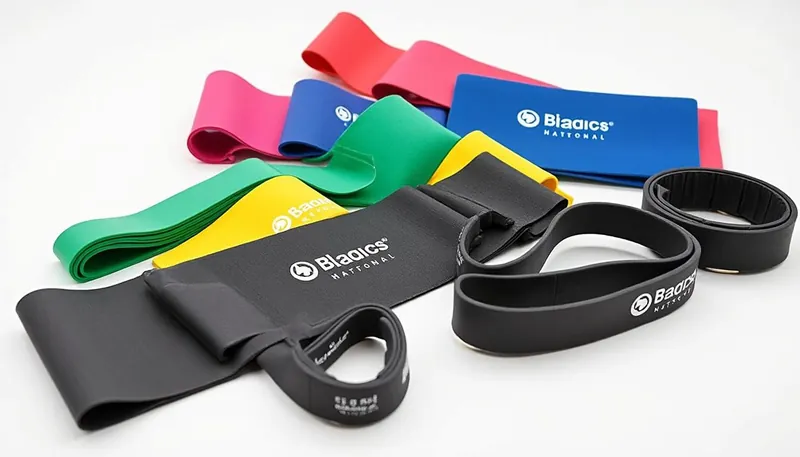In recent years, the fitness community has witnessed an incredible surge in the popularity of resistance bands. Many fitness enthusiasts are now turning to these stretchy bands as a viable alternative—or even a complement—to traditional weight training methods. With their increasing visibility, questions abound regarding their effectiveness, particularly in building muscle. Can these simple rubber bands stimulate hypertrophy on par with dumbbells and barbells? Let’s delve into the intricacies of resistance bands and their muscle-building potential to separate fact from fiction.
As we push forward into 2025, the emphasis on home workouts and convenience within fitness routines has never been stronger. Resistance bands have proven themselves to be an affordable, space-saving alternative that caters to various fitness levels. Not only do they provide varied resistance suitable for progressive overload, but they also allow for a multitude of exercises targeting nearly every muscle group. However, understanding their effectiveness relative to conventional free weights and machines is essential.
Could it be that resistance bands, utilized strategically, focus on muscle engagement and growth just as effectively as free weights? Or is the colloquial belief that they serve mainly for rehabilitation and basic toning overly simplistic? By exploring various arguments, studies, and personal experiences, we can uncover whether resistance bands genuinely hold their ground in the muscle-building arena.
In brief:
- 💪 Resistance bands can enhance muscle stimulation and growth when utilized correctly.
- 📊 Several factors affect the degree of muscle engagement, including resistance levels, exercise selection, and training techniques.
- 🔥 Progressive overload remains crucial for maximizing muscle growth, even with resistance bands.
- 🤔 There are advantages to both resistance bands and traditional weights; combining them may yield the best results.
- 🌟 Accessibility and affordability make resistance bands a great option for many fitness enthusiasts.
Understanding Resistance Bands: Types and Mechanisms
To effectively tackle the question of whether resistance bands can build muscle, it’s vital to understand what these bands truly are. Rather than being a uniform tool, resistance bands come in several styles, each offering unique benefits:
- 🔹 Loop Bands: These endless bands are excellent for lower-body exercises like squats and hip bridges. They are a staple for resistance training aimed at glute activation.
- 🔹 Tube Bands with Handles: Versatile for upper-body workouts, these bands are perfect for presses, pulls, and curls, allowing for various grip options.
- 🔹 Figure 8 Bands: Designed for arm isolation, they’re commonly used for biceps curls and shoulder movements.
- 🔹 Therapy Bands: Often seen in rehabilitation settings, these bands are typically longer and used for mobility and rehabilitation exercises.
Resistance bands work on the principle of variable resistance. The more you stretch them, the greater the resistance they provide, which creates a unique tension curve compared to traditional weights. This dynamic allows for a continuous challenge through the full range of motion. However, this variable resistance poses a question regarding its effectiveness: Does the nature of resistance bands produce sufficient tension across various movements to stimulate muscle growth?

Principles of Muscle Growth Applied to Bands
Key principles govern muscle growth regardless of the equipment utilized, including:
- ✍️ Progressive Overload: To stimulate muscle adaptations, it’s crucial to progressively increase the demands placed on your muscles. This can mean increasing resistance, enhancing rep counts, or reducing rest times during workouts.
- ✍️ Rest and Recovery: Adequate rest between sets is vital to allow muscles to recover and to ensure that strength gains are not limited by cardiovascular endurance.
- ✍️ Variety and Intensity: Incorporating a variety of exercises and intensities throughout workouts ensures comprehensive muscle engagement. This may involve mixing resistance bands with bodyweight workouts or free weight training.
The majority of muscle growth occurs during both eccentric (lowering) and concentric (lifting) phases of an exercise. Resistance bands challenge muscles through these phases, but the effectiveness of this challenge can fluctuate depending on the type and progression of resistance. Can we, therefore, conclude that resistance bands can be an effective tool for hypertrophy, as long as proper techniques are employed?
The Comparison: Resistance Bands vs. Free Weights
Let’s put resistance bands up against traditional weights like dumbbells and barbells in the realm of muscle-building effectiveness. A common belief is that free weights are superior due to the inherent load they provide and the controlled tension they maintain throughout various exercises.
However, there are specific aspects where resistance bands shine:
- 🔹 Portability and Accessibility: Resistance bands can be used virtually anywhere, making them suitable for those with limited space or resources.
- 🔹 Joint-Friendly Resistance: Bands provide a smoother, more forgiving resistance curve that’s easier on the joints, making them ideal for rehabilitation and for individuals with joint concerns.
- 🔹 Variety of Resistance Levels: Bands come in various resistance levels that can accommodate every fitness level—from beginners to advanced lifters.
- 🔹 Enhanced Muscle Activation: The nature of resistance bands often requires more stabilization, engaging different muscle groups and leading to improved motor patterning.
Yet, when it comes down to maximum strength and hypertrophy, free weights maintain an edge. This is primarily due to their ability to load muscles consistently throughout the entire range of motion. As such, free-weight exercises—like the squat or deadlift—often yield greater benefits in terms of muscle hypertrophy as these are compound lifts that efficiently activate multiple muscle groups.
| Aspect | Resistance Bands | Free Weights |
|---|---|---|
| Portability | ✔️ | ❌ |
| Joint Safety | ✔️ | ✅ (depends on form) |
| Heavy Load Capacity | ❌ | ✔️ |
| Versatility | ✔️ | ✔️ |
| Muscle Activation | ✔️ | ✔️ |
The question remains: can resistance bands build muscle sufficiently? For those seeking muscle mass, resistance bands alone may not suffice in the long term. A diversified workout approach combining resistance bands with free weights could yield optimal results.

How to Maximize Muscle Growth with Resistance Bands
For those ready to incorporate resistance bands into their regimen, it is crucial to understand how to maximize their effectiveness. Here are some tips to enhance muscle-building potential:
- 🎯 Increase Tension: Utilize thicker bands—for example, Fit Simplify or WODFitters—that provide increased resistance across a broader range of exercises.
- 🎯 Focus on Tempo: Slow down the repetitions to increase the time under tension during both the concentric and eccentric phases, which can lead to greater muscle fatigue.
- 🎯 Incorporate Compound Movements: Exercises that engage multiple muscle groups help maximize muscle recruitment. Think squats, rows, and presses.
- 🎯 Pre-Activate Muscles: Use bands to warm up, activating the target muscles before diving into heavier lifts or band-specific workouts.
Sample Resistance Band Workout Structure
Here’s a brief example of how to structure a resistance band session targeting major muscle groups:
- 🔹 Warm-Up: Use light bands to perform dynamic stretches for upper and lower body.
- 🔹 Compound Superset: Band squats ➡️ Band rows.
- 🔹 Isolation Lift: Band bicep curls ➡️ Band tricep extensions.
- 🔹 Core Finisher: Band resisted planks or banded deadbugs.
Implementing these strategies will ensure that resistance bands become an effective part of your muscle-building arsenal. Interestingly, as 2025 progresses, more studies reveal the positive impact of resistance bands when integrated with traditional methods. This progressive approach offers substantial benefits to strength training in both amateurs and seasoned lifters alike.
Resistance Bands in the Bigger Picture of Fitness
In the broader landscape of fitness, resistance bands can be a great tool for overall muscle development, functional strength training, and injury rehabilitation. Their adaptability makes them suitable for various exercise protocols, from circuit training to high-intensity workouts. However, there are important limitations to consider:
- 🔻 Limited Maximum Resistance: Resistance bands will ultimately reach a plateau in their strength endurance capabilities compared to heavy weights, making them less suited for advanced strength athletes.
- 🔻 Less Stability: Some exercises may require additional stabilization techniques, potentially limiting effectiveness without proper form.
- 🔻 Durability: Depending on band quality, wear and tear occur over time, influencing workout strategies.
Despite these considerations, the potential benefits of resistance bands resonate well with a diverse array of audiences—be it for rehabilitation, general fitness enhancement, or muscular development. As I often highlight in my training sessions, the key lies in marrying traditional training approaches with innovative tools, leading to a more well-rounded capacity for strength.
Finding the Right Resistance Bands for You
Before embarking on resistance band workouts, selecting the right type is crucial for achieving your goals. Consider popular brands known for their quality:
- 🔸 TheraBand: Renowned for their rehabilitation focus and wide variety of resistance levels.
- 🔸 Bodylastics: Offers high-grade latex resistance bands with unique double-strap technology for added safety.
- 🔸 Letsfit: Affordable but effective bands suited for bodyweight training.
- 🔸 SPRI: Offers various types of bands, from therapy to resistance bands, catering to different workout styles.
- 🔸 ProsourceFit: Known for their durable and diverse band offerings across different resistance levels.
Choosing the right band will empower your strength-building journey, while exploring resistance bands will undoubtedly enhance your awareness of the versatility of fitness tools.
Can I just use resistance bands for muscle building?
Yes, but for optimal hypertrophy, blending bands with free weights is recommended.
What are the best resistance bands for building muscle?
Brands like TheraBand, Fit Simplify, and WODFitters offer a variety of durable options recommended for effective workouts.
How do resistance bands compare to weights in muscle building?
Resistance bands provide effective muscle engagement but generally lack the load capacity of free weights for maximizing strength.
How often should I incorporate resistance band workouts?
Integrating bands 2-3 times a week, combined with free weights, can optimize overall strength gains.
Can resistance bands help with injury rehabilitation?
Absolutely! They are widely used in physical therapy to aid in recovery due to their adaptable resistance.


